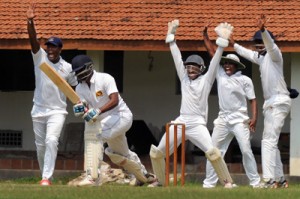How can we avoid the shame of being relegated to Division Two?
View(s):Last week the International Cricket Council (ICC) rekindled the controversy over its radical proposal that would see Test cricket split into two divisions within a structure to promote and relegate member-nations, and make avenues for two new Test-playing nations to emerge.
 It is said that the new proposal is aimed at bolstering the appeal of international cricket and being promoted by its chief executive, David Richardson, who is exploring a number of options that would provide greater context to all three formats of the game from 2019. According to this proposal, there will be seven nations in division one and five in division two, with promotion and relegation decided every two years.
It is said that the new proposal is aimed at bolstering the appeal of international cricket and being promoted by its chief executive, David Richardson, who is exploring a number of options that would provide greater context to all three formats of the game from 2019. According to this proposal, there will be seven nations in division one and five in division two, with promotion and relegation decided every two years.
It is said that based on the current rankings, eighth-placed West Indies would slip into division two, but they would still have full Test status, along with Bangladesh and Zimbabwe. Then the second tier would see the entry of two best teams from the 2015/17 Intercontinental Cup — the first-class competition for associate nations. This would mean Ireland, currently top of the associate member table, would get division two Test status.
The latest Test rankings put out by the cricket governing body reads as follows:
Team Matches Points Rating
Australia 43 4823 112
India 32 3535 110
South Africa 34 3703 109
Pakistan 28 2977 106
England 45 4610 102
New Zealand 39 3755 96
Sri Lanka 35 3123 89
West Indies 33 2504 76
Bangladesh 22 1026 47
Zimbabwe 10 53 5
As it is, the scroll says that if this division becomes a reality it will be the Lankans who will be the wooden-spoonists – a place where we dare not stay too long.
Then we also could talk of the looming realities too. The future of Sri Lankan cricket as things stand today does not look healthy as it should.
Once again the last three sides of the list reads as – The West Indies, Bangladesh and Zimbabwe and they would be relegated to the second division while Ireland joining as the eleventh full member in the ICC rankings.
We just mentioned about the realities and the present and the future of the game of cricket on the International card.
In this scenario, the best yardstick is the dipstick to see how the junior cricket of ICC is performing at the moment. In the just concluded ICC under 19 World Cup, it was the West Indies which won the championship beating India in the final that took place in the Indian sub-continent itself. Then in the fight for the third place, it was hosts Bangladesh which beat Sri Lanka. Bangladesh, which took to serious junior cricket, only when they were conferred with the Test Status in 2000, growing up to beat Sri Lanka that had a hundred year history in quality school cricket is not good news at all.

During a Premier First Class match, players appealing intensively for a dismissal. But the noise doesn’t seem the please the umpire, the final decision maker on the field. The wind has taken this trend towards the present SLC hierarchy - File pic
This depicts that even if the West Indies and Bangladesh are relegated to the second division, they too possess the wherewithal to bail out from their present predicament when one takes into account that their junior cricket is on the upward trend. But, obviously the Lankan junior cricket is not healthy and they are currently in the tail end of a good thing that began with the country winning the 1996 World Cup. Since then like an obese child it had grown in size, but come down in stature and it will not be long before even countries like Nepal and Scotland start beating the junior Lankans on a regular basis.
However, the dilemma grows deeper with the international cricket taken into account. A few moons ago, the Lankans were cock-a-hoop when they dropped only one match while beating the rest of the T-20 World to bag the plum – to be precise it was on April 6, 2014. But early last week, the Lankans had to huff – puff and blow the house down to beat rank outsiders UAE by a thin margin and then went down to Bangladesh with a whimper under a stroke filled onslaught at the hands of little known Shabbir Rahman.
The question is: Is our cricket being guided with wisdom or is it waist deep in a political quagmire that does not seem to have a happy ending in the known future.
The last interim committee led by Sidath Wettimuny recognised the problems at hand, and in a limited period of about eight months took the problem by the horns and worked a programme that promised to take the game of Lankan international cricket to where it belongs.
Working on that blueprint were people like Sidath Wettimuny, Michael Tissera, Mahela Jayawardena and Kumar Sangakkara. Especially, Mahela Jayawardena was right behind that thinking process and he put all his knowledge into that while helping out formulate the Zonal cricket tournament which promised to take the game into a new level. Yes, for anything there is no magic formula. It takes time and shaping while putting it on the right track.
The promoters of the Zonal tournament had a plan to entertain the traditional club cricket segment and its tournament in the same manner. Coming along with that was a new thinking that had tentacles into the rural hub where the outstation cricketers would stay at home and play the game to earn a million cools bucks at the end of the season. The games certainly would be first class cricket akin to county cricket in England.
Ironically, a few days after the Thilanga Sumathipala administration came into power, the proposal was thrown out of the window and the Zonal tournament was dead as the do-do bird. What they should have pondered was to see the positives of the proposals and see if the blue print put into effect with certain amendments with the consent of the author. Remember Mr. Mahela Jayawardena knows a thing or two about international cricket and its latest technicalities.
Now SLC president Thilanga Sumathipala and the former Interim committee chairman are engaged in a huge verbal battle as to why the Wettimuny proposed indoor facility would not become a reality. Sumathipala’s argument is that why does Dambulla need an indoor stadium when the ground has very little rain year around. In reply, Wettimuny points out that Sumathipala has lost the argument point blank. The proposal to have indoor nets in Dambulla was to offer hundreds of cricketers from the North and the North Central Provinces proper facilities to train round the clock. The need for a facility of this nature is to take the game into the next phase of Lankan cricket. What we lament is why have petty politics rule over a game that we almost have come to depend upon. In cricket there is more than the eye could see for the Lankans and the administrators must try to learn those facts initially.
Every person who knows even an iota about cricket is aware that the prevailing Club system is archaic and it does not serve the big picture of international cricket anymore. From the days of when they tried to have a meaningful upper tournament starting with the Robert Senanayake trophy, the administrators have been on the lookout. It changed sometimes only by name and sometimes – then Super Tournament to the Provincial Tournament to the just aborted Zonal Tournament.
But the irony is that the more resistance the new administration puts upon the need to change the game into something that is futuristic and meaningful, the more adverse results Sri Lanka cricket would face, like what we experienced against Bangladesh this week.
I was talking to a present tournament committee member in the aftermath of the ditching of the Zonal Tournament. He said the next cricket season would begin soon with the advent of the customary under 23 tournament, but, where they are heading thereafter they are not sure and how the tournaments would be structured.
Well in England there is county cricket, in Indian it is the Ranji trophy, in Australia it is Sheffield Shield, in South Africa it is state cricket. But, in Sri Lanka they still do not know how they would structure the 2016/17 tournament or what it would be.
Just think.


